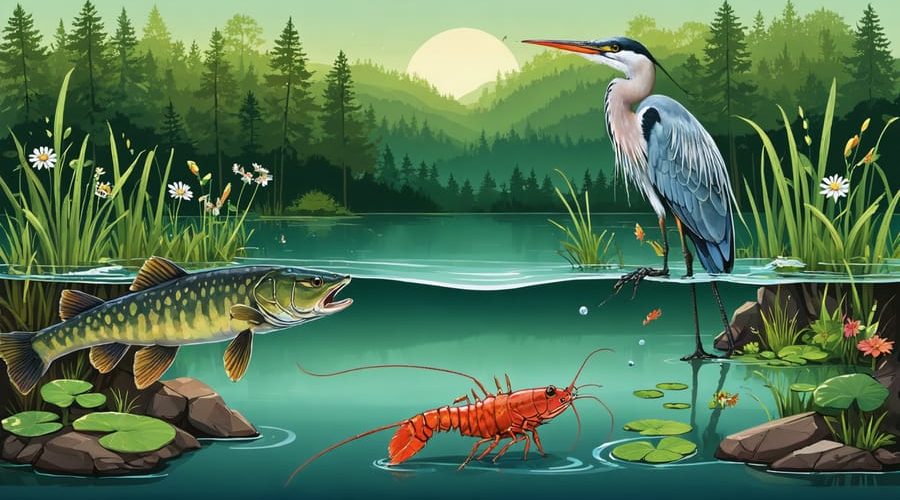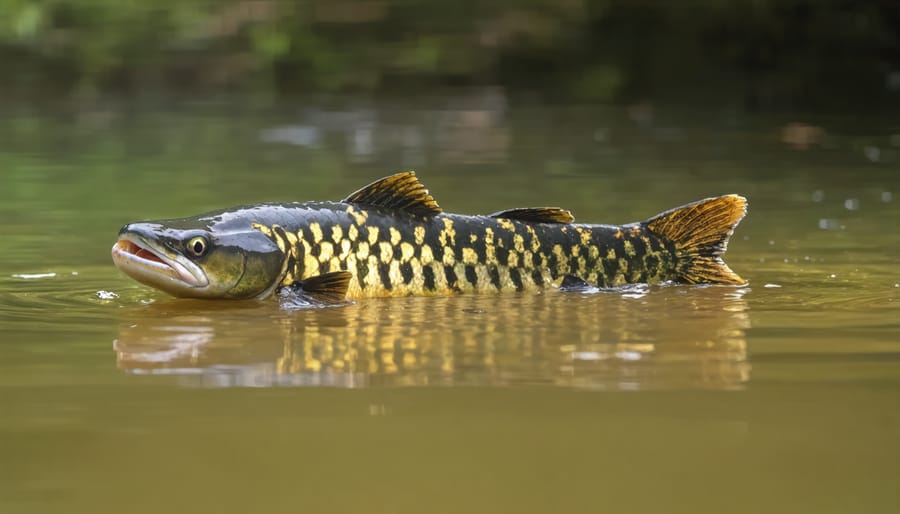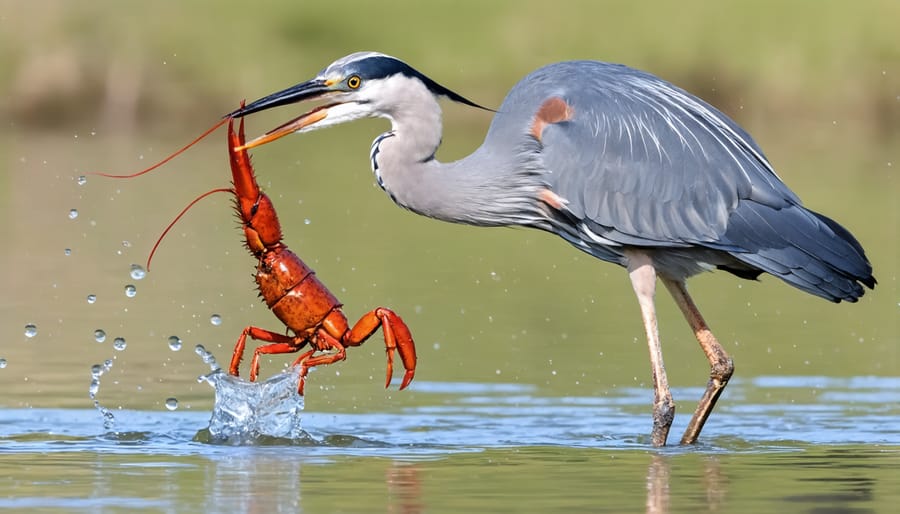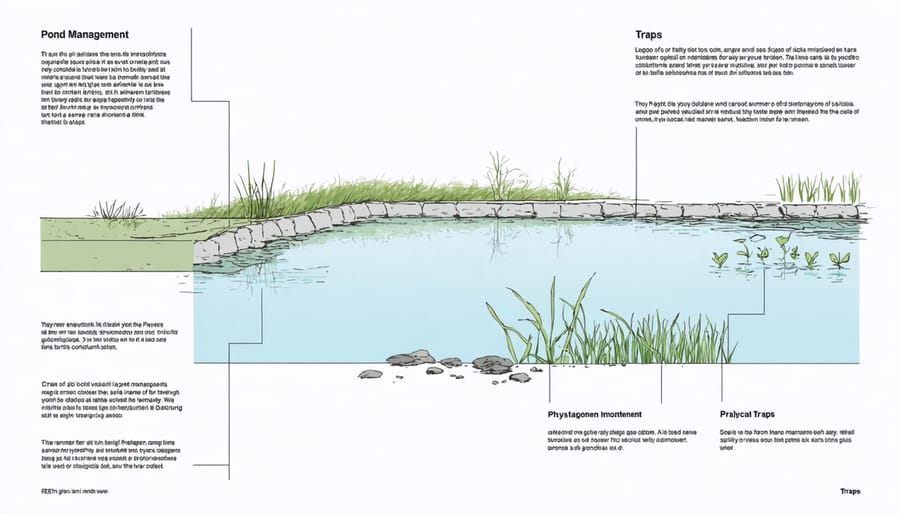
Why Invasive Pond Predators Thrive (And What’s Eating Them)
Invasive species often thrive in pond environments precisely because they lack natural predators, disrupting delicate predator-prey relationships that typically maintain ecological balance. While these unwanted guests might seem unstoppable, nature does eventually catch up. Local predators gradually adapt to feed on invasive species, though this process can take years or even decades. In your backyard pond, this means you’ll likely need a combination of manual control methods and strategic introduction of native predatory species to manage invasive populations effectively. Understanding this dynamic helps pond owners make informed decisions about whether to wait for natural predation to develop or take more immediate action through targeted management strategies. The good news? You’re not powerless against invasive species – there are several proven methods to protect your water garden while working with nature’s own defense mechanisms.
Common Invasive Predators in Pond Ecosystems
Fish Invaders
Invasive fish species like snakeheads and Asian carp have become a significant concern for pond owners and local ecosystems alike. Unlike native fish species that have evolved alongside common pond predators, these newcomers often arrive without their natural checks and balances.
Northern snakeheads, for instance, are particularly problematic because they’re aggressive predators themselves and can survive in various water conditions. They’ve earned the nickname “Frankenfish” due to their ability to breathe air and even travel short distances on land! While larger native predatory fish might occasionally eat young snakeheads, adults have few natural enemies in their invaded territories.
Asian carp pose a different challenge. These hefty fish can grow too large for most native predators to handle, and they reproduce rapidly. They’re famous for jumping out of the water when startled, which can make boating hazardous. In both cases, the lack of effective natural predators has allowed these species to thrive and spread, making it crucial for pond owners to prevent their introduction and report any sightings to local authorities.

Problematic Crustaceans and Amphibians
Red swamp crayfish and bullfrogs are among the most troublesome invasive species in water gardens and natural ponds. These crustaceans and amphibians have become particularly problematic because they often arrive in new environments without their natural predators to keep their populations in check.
Red swamp crayfish, originally from the southeastern United States, are aggressive creatures that can quickly take over a pond. While native predators like large fish, birds, and mammals occasionally feed on them, these crayfish reproduce so rapidly that predation rarely controls their numbers effectively. They’re also equipped with powerful claws and a hard shell, making them challenging prey for local wildlife.
American bullfrogs face a similar situation when introduced to new areas. These large frogs can grow bigger than most native amphibians and have few natural predators outside their original habitat. Adult bullfrogs are too large for many local predators to handle, and their tadpoles often taste unpleasant to fish that might otherwise eat them. This lack of predation, combined with their voracious appetite for native species, makes them particularly destructive in pond ecosystems.
Natural Predators of Invasive Species
Native Fish Predators
Many local fish species can actually help control invasive fish populations in ponds and lakes. Large predatory fish like bass, pike, and walleye are particularly effective at targeting smaller invasive fish species. For example, largemouth bass regularly feed on young Asian carp and round gobies, helping to keep their numbers in check.
Native catfish species are also excellent predators of invasive fish, especially bottom-dwellers like weather loach and walking catfish. Their nocturnal feeding habits make them particularly effective at controlling invasive species that are most active at night.
In smaller water features, native sunfish can help control invasive minnows and small fish. Bluegills and pumpkinseeds are aggressive feeders that will readily consume the eggs and young of invasive species, preventing them from establishing large populations.
However, it’s important to note that native predators alone usually can’t completely eliminate invasive fish once they’re established. The most successful approach combines multiple control methods, including encouraging native predator populations. When stocking predatory fish in your pond, always check local regulations and only introduce species that are native to your area.
For the best results, work with local fish and wildlife experts to determine which native predator species would be most effective for your specific situation. They can help you develop a balanced approach that protects both your pond’s ecosystem and the surrounding waterways.
Birds and Other Wildlife
Birds are nature’s ultimate pest controllers, and they can be surprisingly effective at managing invasive species in and around your pond. Herons, egrets, and kingfishers are particularly helpful in controlling invasive fish populations, while songbirds like warblers and chickadees help keep insect invaders in check.
For pond owners dealing with invasive crayfish or aquatic insects, ducks can be valuable allies. Mallards and wood ducks are especially fond of these creatures and will happily help maintain balance in your water garden. On land surrounding your pond, shrews and moles naturally control invasive grubs and worms that might otherwise make their way into your water feature.
Larger predators like raccoons, foxes, and coyotes also play their part in the bigger picture. While we might think of them as nuisances, they actually help control invasive rodents and other small mammals that could disturb your pond’s ecosystem. Even bats contribute by feeding on invasive moths and other flying insects during the evening hours.
You can encourage these natural predators to visit your pond by creating wildlife-friendly spaces around it. Installing bird houses, maintaining native plants for cover, and avoiding harsh chemicals will help create a balanced ecosystem where beneficial wildlife can thrive. Remember that these natural predators are part of a healthy pond system and their presence usually indicates good ecological balance.

Why Some Invasive Species Lack Natural Predators
When invasive species arrive in a new environment, they often find themselves in a situation that’s similar to hitting the ecological jackpot. Several key factors explain why these unwanted guests can thrive without natural predators keeping them in check.
First, these species usually arrive without the predators that evolved alongside them in their native habitat. Think of it like moving to a new neighborhood where nobody knows your habits or weaknesses. In their original environments, these species developed complex relationships with predators over thousands of years. When they suddenly appear in a new location, those biological controls are left behind.
The local predators in the invaded environment often don’t recognize these newcomers as potential prey. They might not have the right hunting strategies or tools to catch them effectively. For example, some invasive plants produce chemicals that local herbivores find unpalatable or even toxic. Similarly, invasive animals might have defense mechanisms that local predators haven’t evolved to overcome.
Timing also plays a crucial role. By the time native predators might adapt to seeing these invasives as food sources, the invasive population has usually grown so large that predator control becomes ineffective. It’s like trying to empty a bathtub with a teaspoon while the faucet is running full blast.
Climate differences can also work in favor of invasive species. Many thrive in their new homes because the environment lacks the seasonal changes or weather patterns that naturally limited their population growth back home. Without these natural checks and balances, they can reproduce and spread much faster than in their native range.
For pond owners, this explains why simply introducing a few predatory fish might not solve an invasive species problem. The solution often requires a more comprehensive approach, combining different control methods and consistent maintenance to keep these unwanted visitors in check.

Managing Invasive Predators in Your Pond
Managing invasive predators in your pond requires a combination of preventive measures and active control strategies. The key is to prevent invasive species from establishing themselves in the first place, but if they do appear, there are several effective methods you can use.
Start by installing physical barriers like fine mesh screens around your pond’s inlet and outlet pipes. These barriers help keep unwanted fish and other aquatic predators from entering your pond system. Regular monitoring is crucial – check your pond weekly for any signs of invasive species like unusual plant damage or unfamiliar fish.
If you discover invasive fish species, consider using selective trapping methods. Simple fish traps can be effective, but make sure to check local regulations before removing any species. For smaller ponds, you might be able to temporarily lower the water level to make removal easier.
Natural solutions can be very effective too. Adding native plants around your pond’s edge creates hiding spots for beneficial insects and small native fish, making it harder for invasive predators to establish themselves. Consider introducing compatible native fish species that can compete with invasives for resources without harming your desired pond inhabitants.
Remember to maintain proper water quality through regular testing and filtration. Healthy pond ecosystems are naturally more resistant to invasive species. If you’re unsure about identifying or managing specific invasive predators, consult with local aquatic experts or your extension office for guidance tailored to your area.
While invasive species often lack natural predators in their new environments, there are still ways to manage them effectively in your pond. Remember that prevention is your best defense – carefully inspect new plants and animals before adding them to your water feature. If you already have invasive species, consider introducing appropriate native predator species under expert guidance, using physical removal methods regularly, and maintaining optimal pond conditions that favor native species.
For long-term success, combine multiple control strategies and monitor your pond regularly. Stay informed about local regulations regarding invasive species management, and work with neighboring pond owners to create a unified approach. By taking these proactive steps and remaining vigilant, you can help protect your pond’s ecosystem while enjoying a beautiful and balanced water feature that supports native wildlife.
